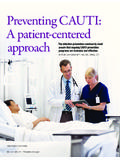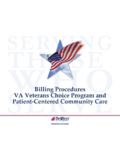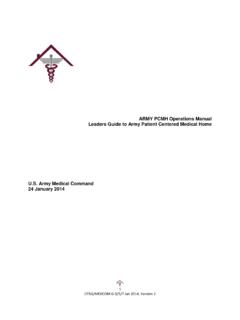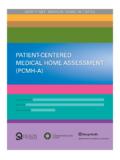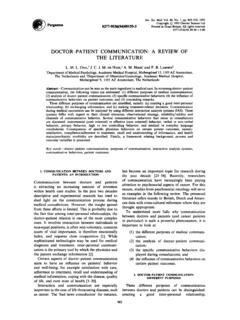Transcription of Tondora, et al., (2007). Yale University School of ...
1 Important Language Considerations in Developing Person- centered Plans Despite the fact that the process behind a recovery plan may be largely recovery-oriented, the translation of this process into the actual language of the planning document itself continues to be a core challenge of all providers who are committed to creating person- centered plans. The following are offered as overarching guidelines that should be considered regarding language that is incorporated in both written documents and verbal interactions. 1. The language used is neither stigmatizing nor objectifying.
2 At all times person first language is used to acknowledge that the disability is not as important as the person's individuality and humanity, , a person with schizophrenia versus a schizophrenic or a person with an addiction versus an addict. Employing person-first language does not mean that a person's disability is hidden or seen as irrelevant; however, it also is not be the sole focus of any description about that person. To make it the sole focus is depersonalizing and derogatory, and is no longer considered an acceptable practice. 2. The language used also is empowering, avoiding the eliciting of pity or sympathy, as this can cast people with disabilities in a passive, victim role and reinforce negative stereotypes.
3 For example, just as we have learned to refer to people who use wheelchairs as opposed to the wheelchair bound we should refer to individuals who use medication as a recovery tool as opposed to people who are dependent on medication for clinical stability.. 3. Words such as hope and recovery are used frequently in documentation and delivery of services. 4. Providers attempt to interpret perceived deficits within a strengths and resilience framework, as this will allow the individual to identify less with the limitations of their disorder. For example, an individual who takes their medication irregularly may be automatically perceived as non-compliant.
4 Lacking insight, or requiring monitoring to take meds as prescribed. However, this same individual could be seen as making use of alternative coping strategies such as exercise and relaxation to reduce reliance on medications or could be praised for working collaboratively to develop a contingency plan for when medications are to be used on an as-needed' basis.. 5. Avoid using diagnostic labels as catch-all means of describing an individual ( , Is a 22-year-old borderline patient with ), as such labels often yield minimal information regarding the person's actual experience or manifestation of their illness or addiction.
5 Alternatively, an individual's needs are best captured by an accurate description of his or her functional strengths and limitations. While diagnostic terms may be required for other purposes ( , classifying the individual to support reimbursement from funders), their use should be limited elsewhere in the person- centered planning document. Tondora, et al., ( 2007 ). yale University School of Medicine Program for Recovery and community Health. New Haven, CT. The Power of Language in Strengths-Based Approaches: The Glass Half Empty, The Glass Half Full (p. 1).
6 What types of messages might be communicated by the language on the left? For each word, try to identify a more strengths-based term or phrase while keeping in mind the principles noted above. Are there other words/phrases in your plans and/or language that you would like to change? Why? The Glass Half Empty The Glass Half Full Deficit-based Language Strengths-based, Recovery-oriented Alternative 1 A schizophrenic, a borderline 2 An addict/junkie 3 Clinical Case Manager 4 Front-line staff/in the trenches 5 Substance abuse/abuser 6 Suffering from 7 Treatment Team 8 LMHA Local Mental Health AUTHORITY.
7 9 High-functioning vs. Low Functioning 10 Acting-out 11 Unrealistic 12 Denial, unable to accept illness, lack of insight 13 Resistant/non-compliant 14 Weaknesses 15 Unmotivated 16 Clinical decompensation, relapse, failure 17 Maintaining clinical stability/abstinence Tondora, et al., ( 2007 ). yale University School of Medicine Program for Recovery and community Health. New Haven, CT. The Power of Language in Strengths-Based Approaches: The Glass Half Empty, The Glass Half Full ( ). What types of messages might be communicated by the language on the left? For each word, try to identify a more strengths-based term or phrase while keeping in mind the principles noted above.
8 Are there other words/phrases in your plans and/or language that you would like to change? Why? The Glass Half Empty The Glass Half Full Deficit-based Language Strengths-based, Recovery-oriented Alternative 18 Puts self/recovery at risk 19 Non-compliant with medications/treatment 20 Minimize risk 21 Consumer (in addictions community ). 22 Patient (in mental health community ). 23 Treatment works 24 Discharged to aftercare 25 Enable 26 Frequent Flyer 27 Dangerous 28 Manipulative 29 Entitled 30 DTO/DTS/GD. 31 Baseline 32 Helpless 33 Hopeless 34 Grandiose 35 User of the system Tondora, et al.
9 , ( 2007 ). yale University School of Medicine Program for Recovery and community Health. New Haven, CT. The Glass Half Empty The Glass Half Full Deficit-based Language Strengths-based, Recovery-oriented Alternative 1 A schizophrenic, a borderline A person diagnosed with schizophrenia who experiences the following . 2 An addict/junkie **A person diagnosed with an addiction that experiences the following . 3 Clinical Case Manager Recovery Coach/Recovery Guide (I'm not a case, and you're not my manager!). 4 Front-line staff/in the trenches Direct care/support staff providing compassionate care 5 Substance abuse/abuser Person with an addiction to substances; substance use interferes with person's life 6 Suffering from Working to recover from; experiencing; living with 7 Treatment Team Recovery Team, Recovery Support System 8 LMHA Local Mental Health AUTHORITY Recovery and Wellness Center 9 High-functioning vs.
10 Low Functioning Person's symptoms interfere with their relationship (work habits, etc.) in the following way . 10 Acting-out Person disagrees with Recovery Team and prefers to use alternative coping strategies 11 Unrealistic Person has high expectations for self and recovery 12 Denial, unable to accept illness, lack of insight Person disagrees with diagnosis; does not agree that they have a mental illness pre-contemplative stage of recovery 13 Resistant/non-compliant Not open to Chooses not to Has own ideas . 14 Weaknesses Barriers to change; needs 15 Unmotivated Person is not interested in what the system has to offer.










